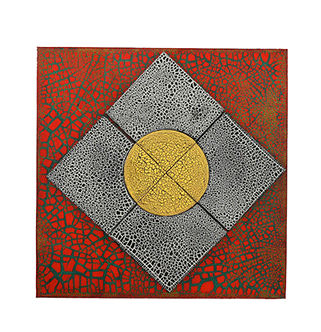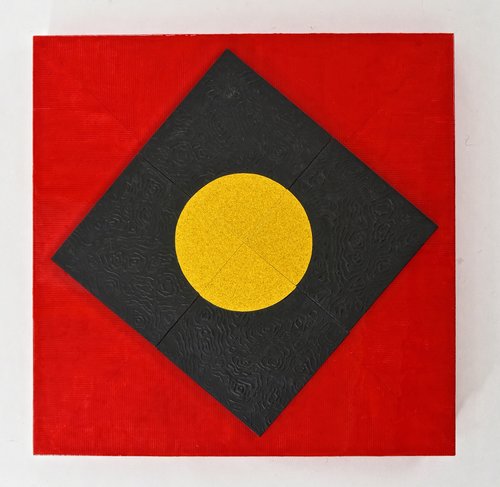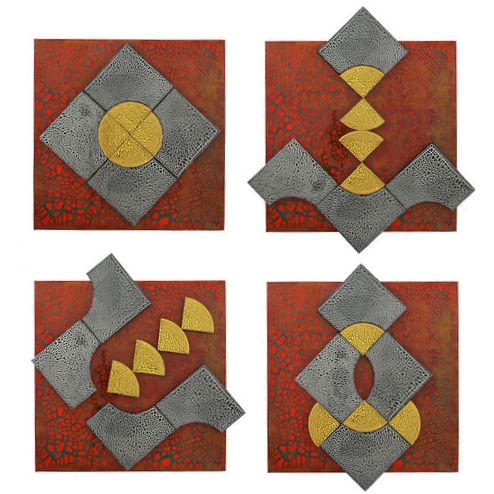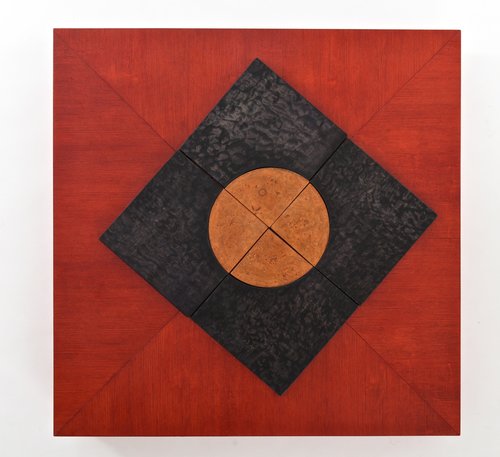by Carolyn Edlund
Canadian artist Majie Lavergne adds a playful interactive element to his work. He invites the viewer to become part of the process. We spoke about using this experiential dimension to move through boundaries.

Artist Majie Lavergne’s work can be arranged in any number of ways. Shown is “Crackle Quadrant” 30″ x 30″
AS: What inspired you to explore the interactive possibilities of art?
ML: In my twenties, I was part of some theatrical experiments led by Jerzy Grotowski, a Polish theater director. He had created these fantastic workshops called Tree of People which would last for days. During that time, people would create spontaneous happenings together. These theatrical happenings led me to redefine what art is or what it can be. I hold a fascination for any art form that plays with or challenges the rigid, traditional boundaries that separate the viewer from the artist. I believe that there is an artist within each of us and that Art, with a big “A” is not solely the territory of artists.
Through my Interactive Art Series called Re-Create I am inviting the viewer to become a participant. I want them to physically engage and create the composition of their liking. The “viewer” becomes part of the process and of the outcome. It’s an invitation into their creativity and their sense of play. To know that my art is used in that way fills me up with joy and brings meaning to my role as an artist.
I also have a background as a psychotherapist and art therapist, so I tend to orient towards fostering collaboration, connection and creativity.

“Paper Quadrant” by Majie Lavergne, 30″ x 30″
AS: What kind of feedback have you gotten? What are people doing with your art?
ML: In general, people love it and totally get the idea behind it. They see it as an opportunity to create, to play, to express themselves, to push their boundaries. For some, it’s like a meditation, or a way to release stress. For others, it’s like being a kid in a sandbox with no right or wrong. It is highly individual and it can become something different accordingly to your mood in the moment, just like life.

Artist Majie Lavergne’s interactive artworks offer a variety of possible compositions.
AS: What do you consider the best market for this art?
ML: I am just starting my marketing efforts, so it may be a bit early for me to say. I’ll be approaching companies (Google, Apple, Facebook, Pixar, advertising agencies, think tanks, etc.) who believe and value the importance of fostering creativity, play and stress release in their work environment. I think companies with a commitment to innovation, creativity and of “thinking out of the box” will understand the value of my Interactive Art Series in their workplace. I believe high-end home designers, community centers and innovative galleries will get it too.

“Wood Quadrant” by Majie Lavergne, 30″ x 30″
AS: What ideas can you share with other artists who would like to include an interactive element in their own work?
ML: Ask yourself, “How can I invite the viewer to become directly involved in my art?” As an example, I think that’s what Lori Katz with her moveable wall art did. I also remember an abstract painter whose work could be rotated in four different positions, as if you had four different paintings for the price of one. I would say “think out of the box.” Push your envelope.


Beautiful, but I’ve got a question. How do all the pieces stay on the wall?? It looks like the pieces can be moved anywhere, so how are they attached?
The pieces can be moved freely, unattached, with the use of very powerful magnets.